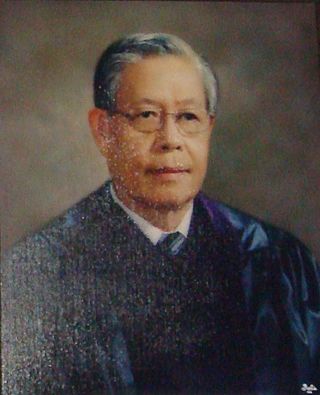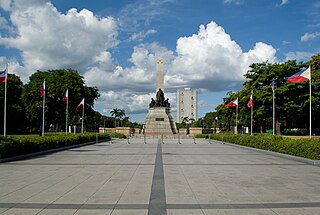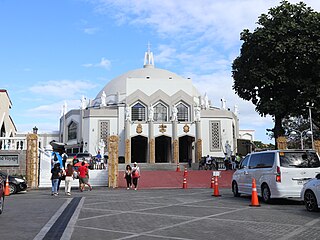Related Research Articles

Malabon, officially the City of Malabon, is a 1st class highly urbanized city in the National Capital Region of the Philippines. According to the 2020 census, it has a population of 380,522 people.

Jaime Lachica Sin, commonly and formally known as Jaime Cardinal Sin, was the 30th Catholic Archbishop of Manila and the third cardinal from the Philippines. He was instrumental in the historic and peaceful 1986 People Power Revolution, which toppled the dictatorship and ended martial law under Ferdinand Marcos and installed Corazon Aquino as his successor in the Fifth Republic of the Philippines. He was also a key figure in the 2001 EDSA Revolution that replaced President Joseph Estrada with Gloria Macapagal Arroyo.

Hilario Gelbolingo Davide Jr. is a Filipino lawyer, professor, diplomat, constitutionalist and former politician, who served as the 20th Chief Justice of the Supreme Court of the Philippines and Permanent Representative of the Permanent Mission of the Republic of the Philippines to the United Nations. As constitutionalist, Davide led the creation of the Legislative branch, and also wrote the most resolutions and the bulk of the 1987 Constitution of the Philippines, becoming its father and primary author.

Rizal Park, Luneta, also known as Luneta Park or simply Luneta, is a historic urban park located in Ermita, Manila. It is considered one of the largest urban parks in the Philippines, covering an area of 58 hectares. The site on where the park is situated was originally known as Bagumbayan during the Spanish colonial period. It is adjacent to the historic Walled City of Intramuros.
World Youth Day 1995 was a Catholic youth festival that took place from January 10 to 15, 1995, in Manila, Philippines. It was the first time for an Asian country to host the event. Pope John Paul II presided over the event, marking his second trip to the country as Pope after his visit in 1981, and also the last papal visit in the country of the 20th century and 2nd millennium.

Benigno Simeón Quiambao Aquino Sr. was a Filipino politician who served as Speaker of the National Assembly of the Japanese-sponsored puppet state in the Philippines from 1943 to 1944.

The Knights of Rizal is an Order of Chivalry from the Philippines, created to honor and uphold the ideals of Philippine national hero José Rizal.

Juan Felipe de Jesús Nakpil, KGCR, KSS known as Juan Nakpil, was a Filipino architect, teacher and a community leader. In 1973, he was named one of the National Artists for architecture. He was regarded as the Dean of Filipino Architects.

The Rizal Monument is a memorial in Rizal Park in Manila, Philippines built to commemorate the executed Filipino nationalist, José Rizal. The monument consists of a standing bronze sculpture of Rizal, with an obelisk, set on a stone base within which his remains are interred, holding his 2 famous novels "El Filibusterismo and Noli Me Tangere". A plaque on the pedestal's front reads: "To the memory of José Rizal, patriot and martyr, executed on Bagumbayan Field December 30 1896. This monument is dedicated by the people of the Philippine Islands."

The Minor Basilica and Metropolitan Cathedral of the Immaculate Conception, commonly and popularly known as the Manila Cathedral, is a Catholic minor basilica and the cathedral church of the Roman Catholic Archdiocese of Manila. It is located in Intramuros, the historic walled city in Manila, Philippines, and is dedicated to the Immaculate Conception of the Blessed Virgin Mary, the principal patroness of the country.
Anastacio Tanchanco Caedo was a Filipino sculptor. His style of sculpture was classical realist in the tradition of his mentor, Guillermo Tolentino.

The Diocese of Antipolo is a Latin Church ecclesiastical territory or diocese of the Catholic Church in the Philippines that comprises the Province of Rizal and the city of Marikina in Metro Manila.

The University of Santo Tomas is one of the oldest existing universities and holds the oldest extant university charter in the Philippines and in Asia. It was founded on April 28, 1611, by the third Archbishop of Manila, Miguel de Benavides, together with Domingo de Nieva and Bernardo de Santa Catalina. It was originally conceived as a school to prepare young men for the priesthood. Located Intramuros, it was first called Colegio de Nuestra Señora del Santísimo Rosario and later renamed Colegio de Santo Tomás in memory of Dominican theologian Saint Thomas Aquinas. In 1624, the colegio was authorized to confer academic degrees in theology, philosophy, and arts. On November 20, 1645, after representations by Vittorio Riccio, Pope Innocent X elevated the college to the rank of a university and in 1680 it was placed under royal patronage.
The national symbols of the Philippines consist of symbols that represent Philippine traditions and ideals and convey the principles of sovereignty and national solidarity of the Filipino people. Some of these symbols namely the national flag, the Great Seal, the coat of arms and the national motto are stated in the Flag and Heraldic Code of the Philippines, which is also known as Republic Act 8491. In the Constitution of the Philippines, the Filipino language is stated as the national language of the Philippines. Aside from those stated symbols in the Constitution and in Republic Act 8491, there are only six official national symbols of the Philippines enacted through law, namely sampaguita as national flower, narra as national tree, the Philippine eagle as national bird, Philippine pearl as national gem, arnis as national martial art and sport and the Filipino Sign Language as the national sign language. Thus, there is a total of twelve official national symbols passed through Philippine laws.

Jose Lorenzo de Ocampo (1906–1995) was a Filipino architect and artist.

José Lázaro Fuerte Advíncula Jr. is a Filipino prelate of the Catholic Church and a professed member of the Dominican Order, who became 33rd Archbishop of Manila on June 24, 2021. He became a cardinal in November 2020. He previously served as bishop of San Carlos from 2001 to 2011 and Archbishop of Cápiz from 2011 to 2021. On December 16, 2020, Pope Francis appointed Cardinal Advincula as a member of the Dicastery for Clergy.
1972 in the Philippines details events of note that happened in the Philippines in the year 1972.
Fidel Villarroel was a Spanish historian, writer, filipinologist, biographer, political commentator, Master Theologian of the Dominican Order, and member of the Order of Isabella the Catholic. A recipient of the Pro Ecclesia et Pontifice, he is the former Archivist, Spanish Department Director, Prefect of Libraries, and professor at the Pontifical and Royal University of Santo Tomas. He had also served as secretary to the Apostolic Nunciature for 32 years(1959–1991), and is currently an academic director of the prestigious Academia Filipina de la Lengua Española, the local branch of the renowned Real Academia Española based in Madrid, Spain, and part of the Asociación de Academias de la Lengua Española.

Pope Francis made a pastoral and state visit to the Philippines from January 15 to 19, 2015. He was the third pontiff to visit the Philippines after Paul VI in 1970 and John Paul II in 1981 and 1995, and officially the first papal visit in the 21st century and 3rd millennium after the title was originally scheduled for World Meeting of Families in 2003 but postponed due to John Paul II was unable to attend because of the progression of his Parkinson's disease. Besides Manila, Francis visited Tacloban and Palo, Leyte, to encourage the victims of Typhoon Haiyan (Yolanda) and Typhoon Hagupit (Ruby). The Filipinos nicknamed Francis Lolo Kiko as a term of endearment, which he commended. Around 6–7 million attended Francis' final Papal Mass at Luneta, surpassing the crowd at World Youth Day 1995 in the same venue and making it the largest papal crowd in history. The theme of Francis' 2015 visit was "Mercy and Compassion".

Nemesio “Nemi” R. Miranda Jr., also known as Nemiranda, is a Filipino painter and sculptor in Angono, Rizal. He gained fame as the forerunner the art form “Imaginative Figurism”. He has a degree in Bachelor of Fine Arts from University of Santo Tomas, Manila, Philippines. He is the father of modern artist Keiye Miranda.